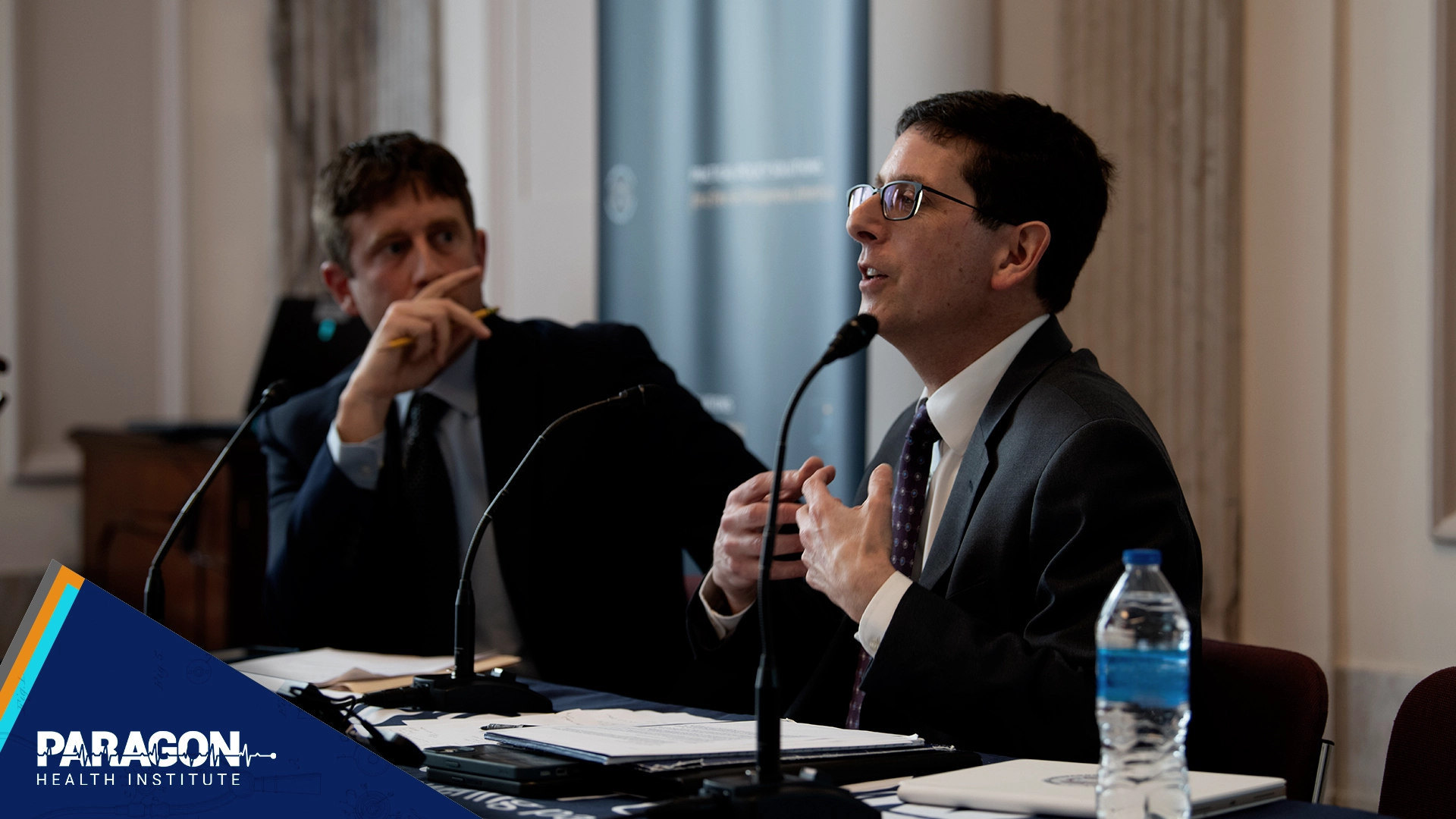Paragons’s President Brian Blase and Senior Policy Analyst Joe Albanese respond to the House Budget Committees’ request for information for their new congressional working group on solutions to reduce government improper payments.
Dear Chairman Arrington, Chairman Comer, and Chairman Sessions:
Thank you for your request for information for your new congressional working group on solutions to reduce government improper payments. It is heartening to see your efforts to tackle an issue that can have profound impacts on the fiscal health of critical federal programs and the real-world health of Americans who rely on them.
Last year, the Paragon Health Institute analyzed the Center for Medicare and Medicaid Services’ (CMS’s) annual report on improper payments in federal health programs.1 Our response will focus on the nation’s two largest federally funded health programs: Medicare and Medicaid. An enormous amount of money—roughly $130 billion annually—spent through federal health programs, predominantly these two, does not comply with program rules. Questionable data collection practices mean that actual improper payments are actually much higher than reported.
Background
Between 2016 and 2022, CMS reported that health programs such as Medicare, Medicaid, and the Children’s Health Insurance Program (CHIP) made about $800 billion in improper payments. The program with the most improper payments is Medicaid: CMS’s 2022 report estimated that about 15.6 percent of Medicaid payments, or $80.6 billion, were improper. Improper payment rates were 26.8 percent for CHIP, 7.5 percent for Medicare Fee-forService (FFS), 5.4 percent for Medicare Advantage (MA), and 1.5 percent for Medicare Part D. Total reported improper payments across CMS programs was $131.6 billion in 2022.
Official figures by CMS underestimate these improper payments. CMS did not conduct eligibility reviews in Medicaid and CHIP for several years, leading to artificially low improper payment rates for those programs in the 2015-2020 reports. During these years, Medicaid enrollment greatly increased due to the Affordable Care Act’s (ACA’s) expansion of the program. Policy “flexibilities” during the COVID-19 pandemic, such as a pause on improper payment activities, impacted the 2020-2022 reports. Eligibility problems are the biggest driver of improper payments in Medicaid. The Urban Institute estimated that there were 16 million ineligible Medicaid enrollees in September 2022.
Medicaid
In 2021, CMS reported a record-high improper payment rate of 22 percent for Medicaid, or roughly $100 billion in improper federal spending.2 This estimate was artificially low given that the Biden administration allowed states to postpone eligibility determinations and reduce requirements for providers during the pandemic.3
Roughly 80 percent of Medicaid improper payments are tied to eligibility errors. Improper enrollment largely results from the failure of states to properly verify income, citizenship, residence, incarceration status, and even whether people are still alive. Some individuals have multiple enrollments in the same state or across states. Also, many people do not report changes in their life circumstances that may impact eligibility.
Wasteful spending in Medicaid has persisted for decades. In 1982, the U.S. House of Representatives Select Committee on Aging issued a report concluding that “state enforcement of the Medicaid program has been an unmitigated disaster.”4 In 2003, the Government Accountability Office (GAO) added Medicaid to its list of high-risk programs.5 In CMS’s fiscal year 2010 annual report to Congress on the Medicaid Integrity Program, CMS noted that Medicaid is “a target for those who would abuse or defraud a health care program for personal financial gain” and that “fraud, waste, and abuse represent a persistent, pervasive threat” to the integrity of Medicaid and other health care programs.6
A 2012 House Oversight Committee report laid some responsibility with the lack of meaningful federal oversight:
Because states lack adequate incentives to combat fraud and abuse in their Medicaid programs, the federal government’s oversight role is even more critical. Unfortunately, CMS often fails to prioritize Medicaid program oversight….
Such disregard by CMS was noted by GAO in a 2005 report. In the report, GAO revealed: [T]he resources CMS expends to support and oversee states’ Medicaid fraud and abuse control activities remain out of balance with the amount of federal dollars spent annually to provide Medicaid benefits. In fiscal year 2005, CMS’s total staff resources allocated to these activities was about 8.1 full-time equivalent (FTE) staffing units…. At the time only eight out of the Department of Health and Human Services’ 65,000 employees were tasked with combating Medicaid fraud and abuse when the program had a nearly $300 billion annual budget.7
Because of the open-ended federal reimbursement of state Medicaid expenditures, states have an incentive to create artificial expenditures to use as the state contribution and then obtain federal reimbursement on that artificial expenditure. For example, a state will assess a so-called provider tax on Medicaid providers, use the revenue raised as part of its payment for Medicaid services provided by those providers, receive federal reimbursement for that payment, and then take a portion of the federal reimbursement to increase the payment to the providers. The provider and state benefit from this accounting gimmick, with federal taxpayers holding the bag.
Medicare
GAO designated Medicare as a high-risk program in 1990 due to its size, complexity, effect on the federal budget and health care sector, and susceptibility to mismanagement and improper payments.8 Importantly, Medicare is the largest single U.S. health care program and the second-largest federal program with $905 billion in 2022 spending.9 The Medicare program’s sheer size indicates that improper payments must remain an important concern for policymakers.
CMS’s annual report of improper payments breaks down Medicare into components with separate data: Medicare FFS, MA (also called Part C), and Part D. In its most recent report, improper Medicare payments slightly increased for FFS (from 6.3 percent to 7.5 percent) and Part D (from 1.3 percent to 1.5 percent) while decreasing in MA (from 10.3 percent to 5.4 percent). While Part D improper payment rates are consistently and significantly lower than the rest of Medicare, rates for FFS and MA are typically within two percentage points of each other.10
Documentation problems—such as failing to submit medical records along with billing records—are the most common form of improper Medicare payment.11 One factor that sets MA and Part D apart from FFS is that their private plans can deploy more tools to control improper utilization, such as prior authorization requirements.
Solutions
Target Utilization Management Practices to Areas with Higher Risk of Improper Payments
The Trump Administration’s fiscal year 2021 budget proposed expanding CMS’s authority to require prior authorization for items and services at high risk of fraud, waste, and abuse in Medicare, which the Department of Health and Human Services (HHS) estimated would save more than $13.7 billion over 10 years.12 It also proposed establishing a prior authorization program for practitioners with significantly higher utilization of certain services relative to others, citing therapy services, advanced imaging, and other services as potential areas of focus. HHS and the Congressional Budget Office (CBO) did not have budgetary estimates of this budget proposal, but there is evidence that such services are rife with improper payments. For example, a recent HHS Office of Inspector General (OIG) report found $580 million in improper payments for psychotherapy services in Medicare from March 2020 to February 2021.13
Furthermore, a 2018 GAO report recommended that CMS increase its use of prior authorization.14 While CMS took some actions since that report’s publication, such as resuming a demonstration for home health services, other actions remain incomplete, such as GAO’s recommended use of prior authorization for certain durable medical equipment products.15 Policymakers should give CMS more tools to reduce improper payments in Medicare in alignment with GAO and budgetary recommendations.
Expand Auditing
There are multiple programs aimed at detecting and recovering improper payments in Medicare with audits. Such audits may be conducted by government entities—for example, the Health Care Fraud and Abuse Control program coordinates government law enforcement activities using a single funding source—or by private companies on the government’s behalf, such as recovery audit contractors who retain a percentage of their recoveries as payment.16 Such audits can directly recover improper payments and also deter future improper payments.17
CMS has recently begun to explore ways to increase its recoveries from program audits. In 2022, it finalized changes to its Risk Adjustment Data Validation program, which verifies the accuracy of payments to MA plans. Under this rule, CMS will use audits to calculate an overall level of payment error rate and recovery overpayments based on an extrapolation of those results.18 Applying this audit methodology to settings where upcoding can result in overpayments by Medicare, such as inpatient hospital settings, can further reduce improper payments through recoveries (both direct and extrapolated) and deterrence.19
Audit Hospital Presumptive Eligibility
In a 2019 audit, HHS estimated that roughly 43 percent of sampled spending on presumptively eligible enrollees was improper.20 Data provided by state Medicaid agencies reveals that just 30 percent of individuals that hospitals determined “presumptively eligible” were ultimately determined eligible for Medicaid by the state.21 In California, for example, hospitals determined nearly 500,000 individuals presumptively eligible between April 2019 and March 2021, but the state enrolled only 155,000 after completing full eligibility reviews.22
CMS should make appropriate recoveries. GAO or HHS OIG should make recommendations to Congress and the Department of HHS on how to reduce the money lost because of hospital presumptive eligibility.
Expand Third-Party Liability
Many Medicaid enrollees have additional sources of insurance coverage. Thus, the government is likely paying insurance companies for people who should not be enrolled and are not using Medicaid services. This problem significantly increased during the pandemic, with CBO estimating about 27 million people with dual coverage in 2023.23
States have two main sources of information on whether there may be a liable third party for a particular claim: (1) Medicaid enrollees themselves and (2) data matches with other insurers or data clearinghouses.
CMS should make appropriate recoveries. GAO or HHS OIG should estimate the magnitude of the problem and recommend recoveries that states owe the federal government as well as recommendations to reduce this problem going forward.
Monitor Financing Schemes and Supplemental Payments
Inappropriate state financing arrangements effectively increase the federal matching rate established under federal law by increasing federal expenditures while state contributions remain unchanged or even decrease.24 Often states use additional money obtained through Medicaid on non-Medicaid services.25 State financing arrangements undermine the integrity of the program because they enable states to make payments to government providers that could significantly exceed their costs despite a statute requiring states ensure that Medicaid payments are economical and efficient.26
GAO or HHS OIG should publish a report that clearly explains the problem of inappropriate financing and payment schemes, including directed payments, to Congress. This report should quantify the extent of the problem and identify the providers to which states direct greater Medicaid payments. GAO or HHS OIG should also make recommendations to Congress on how to reduce these financing and payment schemes.
Enhance Oversight of CMS to Ensure Medicaid Payments Are Economical and Efficient and Otherwise Lawful
From the 2012 House Committee on Oversight and Government Reform report:
As part of the Deficit Reduction Act of 2005, Congress created a Medicaid Integrity Program (MIP) and increased CMS resources directed toward combating Medicaid fraud and abuse. Within a year of MIP’s creation, CMS developed two data systems in an effort to improve data quality and to better detect waste, fraud, and abuse. In July 2011, GAO conducted an analysis of the effectiveness of CMS’s new Medicaid data systems and concluded there was insufficient evidence to support any notion that either system had thus far provided a financial benefit. In addition, GAO identified significant problems with state-reported Medicaid data. CMS generally cannot conduct any substantive analysis until at least one year has passed since the date of the Medicaid service. Moreover, the Office of the Inspector General noted that the state data “has not captured many data elements that can assist in fraud, waste, and abuse detection.” Despite spending hundreds of millions of dollars on information technology, CMS still cannot effectively analyze state Medicaid data.27
Either GAO or HHS OIG should audit CMS’s program integrity efforts on Medicaid and make recommendations to Congress on how to improve them.
Increase Managed Care Company Oversight
While focusing oversight on HHS and CMS is vitally important, much of the growth in improper Medicaid spending is in dollars funneled through health insurance companies. As such, health insurers could shed light on numerous problems with the program, including improper eligibility and financing and payment schemes.
The committee should request information from insurers on these matters, as insurers will be much more responsive than providers are to congressional oversight efforts.
Specific Request to the GAO on Financing Gimmicks and Supplemental Payments
In order to help inform future congressional and administrative efforts to improve and protect the Medicaid program, Congress should request GAO to do the following:
- Determine the facilities that receive the highest supplemental payments in the country. For facilities that receive supplemental payments that appear to be excessive relative to total facility revenue, request documents and communications from states and facilities about the determination of supplemental payment amounts. Moreover, provide information about the amounts that those facilities spend lobbying state governments.
- Evaluate the quality and effectiveness of CMS oversight of states’ use of provider taxes, provider donations, state directed payments, intergovernmental transfers, and certified public expenditures and provide recommendations for reform.
- Quantify the actual state and federal shares of Medicaid expenses after factoring the numerous accounting gimmicks that states employ.
- Estimate how much of federal money obtained through state financing gimmicks such as provider taxes, provider donations, intergovernmental transfers (IGTs), and certified public expenditures (CPEs) goes toward health care versus other purposes.
- Scrutinize the accuracy of upper payment limit (UPL) calculations, including answering the following questions:
- Do the actual amount of UPL payments made exceed the limit calculated? For example, are there discrepancies between spending reported on state UPL demonstrations and actual spending reported on CMS expenditure reports?
- Are the limits calculated on UPL demonstrations routinely used in the review of claimed expenditures?
- Are total base and supplemental FFS spending on CMS-64 expenditure reports exceeding the state-calculated UPL?
- What is CMS’s process to formally review the accuracy and completeness of UPL demonstrations or use these limits in its review of claimed expenditures? Is CMS’s process effective?
- Determine whether a state agency’s methodology to calculate the inpatient UPL is in accordance with CMS regulation and determine if the state included supplemental payments when calculating disproportionate share hospital (DSH) specific payment limits. For example:
- Did a state include all hospital inpatient providers in its calculations or use the most accurate Medicaid claims payment data available as a basis for its UPL calculation?
- Analyze consulting arrangements that states use pertaining to any of the following:
- Any provider tax under section 1903(w),
- Any IGT or CPE, and
- Any other financing scheme that attempts to maximize federal funding for Medicaid services or administration.
These consulting services pertain to the design, modeling, analysis, implementation,
operation, modification, and associated federal and state review, state plan
amendments, waivers, and reports.
Specific Request to the HHS OIG on Eligibility
Congress should audit state eligibility systems and front-end verification processes to quantify the size and scope of Medicaid eligibility errors across the country, identifying for a select sample of recipients:
- The reason for their ineligibility,
- The number and types of databases and eligibility factors considered at time of enrollment,
- The approximate time individuals were ineligibly enrolled,
- The approximate dollar amount spent on recipients while ineligible,
- The approximate dollar amount delivered to insurance companies on behalf of ineligible enrollees, and
- The time lapsed since ineligible recipients’ last determinations.
Medicaid eligibility often relies heavily on presumptive eligibility determinations, where people are enrolled in the program without their eligibility information being thoroughly evaluated. Part of the audit should include a review of issues with presumptive eligibility determinations, including:
- The percentage of sampled recipients who were incorrectly determined eligible through presumptive eligibility. From that percentage, calculate an estimate of
the total number of recipients who were incorrectly presumptively approved for coverage. - From the sample, the total number of months that incorrectly determined recipients received benefits before being removed. From the sample, calculate
an estimate of the total amount of improperly received benefits. - The estimated dollar amount of improper spending in large states such as California, New York, Texas, and Florida as the result of improper presumptive
eligibility determinations. - An analysis of the origin of the initial enrollment (a field office, a hospital, etc.) for people who were inappropriately determined eligible for Medicaid through presumptive eligibility.
Finally, a significant source of improper Medicaid eligibility determinations results from the incentives that states face from the ACA expansion of the program. Because the federal government reimburses a much higher percentage of expenses for expansion enrollees than for previously eligible enrollees, states have incentives to misclassify recipients as eligible under the expansion. As such, your work should select states to identify the degree that states have classified recipients eligible for Medicaid under pre-ACA criteria as ACA expansion enrollees:
- How many recipients have been misclassified;
- The total dollar amount resulting from such misclassifications; and
- Any correspondence between state and federal officials on this topic, including but not limited to informal guidance or direction given.
Thank you for the opportunity to contribute to this critically important working group. Please do not hesitate to reach out to discuss these recommendations further.
Sincerely,
Brian C. Blase
President
Paragon Health Institute
Joe Albanese
Senior Policy Analyst
Paragon Health Institute






